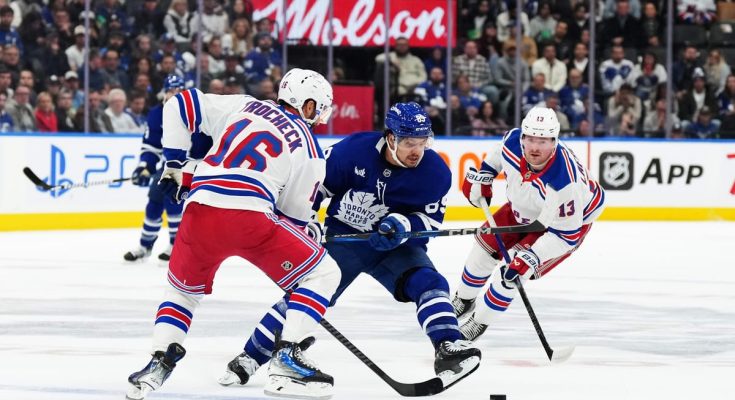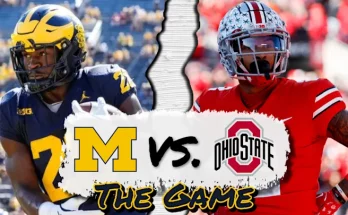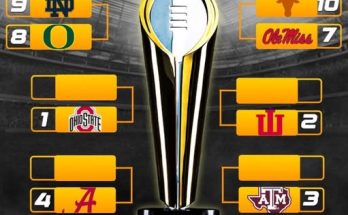The 2025 NHL offseason has been anything but quiet, with rumors flying in every direction, and two franchises seemingly always caught in the whirlwind of speculation are the New York Rangers and the Toronto Maple Leafs. Each team carries a unique brand of pressure and expectation, both facing questions about their current roster construction and how close they are to reaching the ultimate goal of a Stanley Cup. With the two organizations looking to take the next step, it begs the question that fans, analysts, and executives are quietly mulling over: is there a trade to be had between the New York Rangers and the Toronto Maple Leafs?
At first glance, these two Original Six franchises don’t appear to be natural trade partners. Toronto has been traditionally known for its offensive firepower led by stars like Auston Matthews, Mitch Marner, and William Nylander, while their blue line has struggled to maintain consistency in the postseason. New York, on the other hand, has built a strong goaltending pipeline and boasts a dependable defensive core, but has often lacked the dynamic, top-tier scoring that can make the difference in tightly contested playoff matchups. It’s these complementary strengths and weaknesses that make the trade concept not only feasible but potentially beneficial for both sides.
For the Rangers, their recent playoff exits have highlighted some core deficiencies that need to be addressed if they’re going to evolve from perennial contenders to championship favorites. Their top-six forwards are talented, but streaky. Artemi Panarin had a fantastic regular season but struggled again in the playoffs. Mika Zibanejad remains a solid two-way center, but New York often finds itself in need of that game-breaking scorer who can carry the team through adversity. Filip Chytil’s injury history and the inconsistency of younger wingers like Kaapo Kakko and Alexis Lafrenière have only added to the calls for a true offensive upgrade.
Enter Toronto, a team whose fan base is fatigued by repeated early-round exits despite boasting a roster filled with All-Star talent. Their core has remained intact for several years now, with Matthews, Marner, Nylander, and Tavares shouldering most of the load. However, the lack of playoff success has placed immense pressure on the front office to consider breaking up the core in exchange for more depth or defensive prowess. As things stand in the post-2025 draft landscape, the Maple Leafs still haven’t addressed some glaring holes on the blue line and in net. Joseph Woll showed flashes, but consistency remains a question, and Ilya Samsonov’s reliability hasn’t met expectations. Meanwhile, the loss of veteran defensemen in free agency and minimal returns from recent prospects leave the Leafs vulnerable defensively.
This brings both organizations to a familiar crossroad. The Leafs need to add defensive structure and possibly a goaltending solution. The Rangers need high-octane offensive talent who can thrive in postseason conditions. On paper, there is a match to be explored. One potential framework revolves around the Leafs exploring the possibility of moving Mitch Marner—an elite winger with playmaking abilities that could transform the Rangers’ top line. While controversial, Marner has become a frequent topic of trade discussions. With his contract entering its final year and talks about an extension potentially stalling, the Leafs may feel compelled to move him rather than lose him for nothing or commit significant cap space long-term to a core that has not delivered playoff results.
For the Rangers, Marner represents a major upgrade in transition and offensive zone possession. Paired with a sharpshooter like Panarin or Zibanejad, his ability to control tempo and make precise passes through tight defenses could make the difference in future playoff battles. The Rangers could offer a package including a younger, high-upside forward like Kaapo Kakko or Lafrenière, along with a top-four defenseman like Jacob Trouba or K’Andre Miller, depending on Toronto’s priorities. The inclusion of draft capital would almost certainly be necessary to make such a blockbuster work, as well as balancing cap hits given Marner’s $10.9 million AAV.
On the flip side, a deal like this helps Toronto reshape its roster without bottoming out. Adding a strong defender like Trouba—who brings leadership, grit, and defensive awareness—would immediately bolster their blueline. If the Rangers prefer to retain their veterans, the Leafs could also target younger blue-liners like Braden Schneider, who has shown promise as a future top-pair defenseman. Adding Kakko or Lafrenière gives Toronto a younger, cost-controlled forward with potential to blossom in a new system and potentially fill the offensive gap left by Marner. With the right coaching and a new environment, it’s not unrealistic to imagine one of them breaking out the way so many players do when given top-line responsibilities.
Of course, complications abound. Any trade involving high-profile players like Marner will be scrutinized endlessly, and both franchises have been historically hesitant to make drastic core-altering moves unless pushed by circumstances. Additionally, there’s always the ever-present issue of cap management. Both teams are up against the ceiling, and any trade must either involve retention of salary or a swap that balances AAV nearly dollar-for-dollar. That in itself can often be the death knell for a big-name trade. But the flat cap world has also taught GMs to get creative. Third-party facilitators, conditional picks, and sign-and-trade scenarios are increasingly common mechanisms to make the numbers work.
There’s also a philosophical layer to all this. New York has been building steadily through a mix of youth and veteran acquisitions, and making a win-now move like trading for Marner would signal a shift in priorities. That might accelerate their window, but it also puts pressure on young players to deliver instantly. For Toronto, moving a franchise icon like Marner would send shockwaves through their fanbase and locker room, particularly if the return doesn’t produce immediate results. It would also require buy-in from ownership and the assurance that Matthews remains committed for the long haul—something that can’t be taken for granted in this league.
Another potential avenue involves a less dramatic trade. Instead of a superstar swap, the Rangers and Leafs could explore a more surgical transaction. For instance, Toronto might target a middle-pair defender and penalty kill specialist from the Rangers—perhaps someone like Ryan Lindgren—in exchange for one of Toronto’s surplus wingers or prospects. This wouldn’t be a headline-grabbing move, but it would address team needs more subtly and perhaps act as a precursor to a larger transaction later in the season.
There are also goaltending implications to consider. While the Rangers are set with Igor Shesterkin, their pipeline includes promising young netminders that could appeal to the Leafs. If Toronto believes Woll isn’t the long-term answer, they might inquire about New York’s AHL talent or even seek a depth netminder with NHL experience. In that case, the Leafs could offer a second-round pick or a forward prospect to sweeten the pot. This kind of incremental roster adjustment is often more realistic in the modern NHL, where parity reigns and blockbuster trades are rare.
Still, the allure of a major trade remains tantalizing for both fanbases. New York fans have grown increasingly impatient watching their team fizzle out in the postseason, while Leafs Nation has reached a breaking point with what feels like an annual early exit from contention. Both franchises are operating in pressure cookers where media scrutiny and legacy expectations combine into a toxic brew of anxiety and urgency. The right trade—if it can be found—could be the difference between another wasted season and a legitimate Stanley Cup run.
Ultimately, whether or not a trade happens between the Rangers and Maple Leafs comes down to timing, need, and bravery. Both GMs—Chris Drury for New York and Brad Treliving for Toronto—have the pieces to pull off a significant deal, but it would require a willingness to take risk and potentially shake the identity of their respective teams. These are not the types of trades that occur often, but when they do, they reshape franchises and define legacies. In a league where the margins are razor-thin and windows of opportunity close quickly, the question might not be whether there is a trade to be had—but whether either side has the courage to make it.



